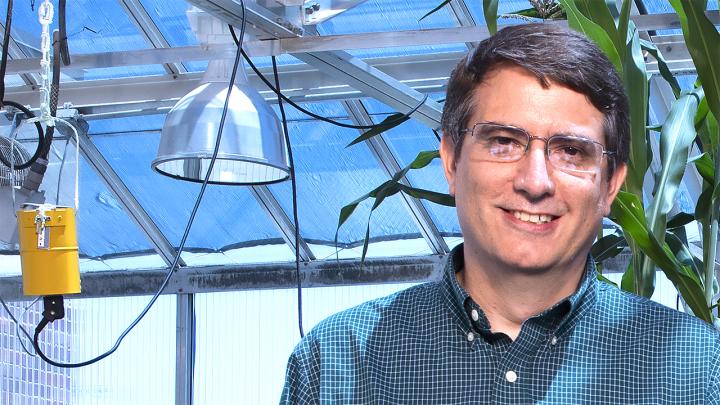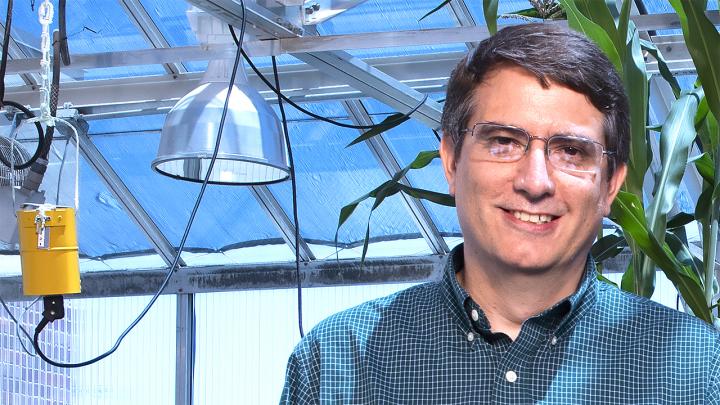
Credit: Craig Chandler, University of Nebraska-Lincoln
Decades after scientists discovered hundreds of different fatty acids in vegetable oils, two that had managed to elude detection have finally revealed themselves to a team led by the University of Nebraska-Lincoln and Huazhong Agricultural University in China.
Named for the sites of the two leading institutions, Nebraskanic acid and Wuhanic acid make up nearly half of the seed oil found in the Chinese violet cress, a flowering plant native to central China.
The discovery may be the first of its kind since the 1960s and 1970s, the researchers said, when biochemists identified troves of new fatty acids in various vegetable oils.
"People thought maybe they'd found everything there was to find," said Nebraska's Ed Cahoon, a George Holmes University Professor of biochemistry who co-authored an Aug. 27 study on the discovery in the journal Nature Plants. "It's been at least several decades since somebody has discovered a new component of vegetable oil like this."
Fatty acids represent the primary components of vegetable oils, which are best known for their role in the kitchen but have also found use in biodiesel fuels, lubricants and other industrial applications. The structure of the fatty acids housed within an oil help dictate both its health effects and industrial merits.
Most off-the-shelf vegetable oils, such as canola or soybean oil, contain the same five fatty acids. Those conventional fatty acids all contain either 16 or 18 carbon atoms and feature similar molecular structures. By contrast, Nebraskanic and Wuhanic rank among a class of "unusual" fatty acids that contain fewer or more carbon atoms – both have 24 – and uncommon molecular branches that stem from those carbons.
Whether conventional or unusual, all known fatty acids generally obey the same instruction manual: They add two carbon atoms at the end of a four-step biochemical cycle, then continue doing so until assembly is complete. But the Nebraskanic and Wuhanic acids seem to go off-book, Cahoon said, in a way rarely if ever seen outside of certain bacteria.
Both acids appear to follow the traditional script until adding their 10th pair of carbon atoms, Cahoon said. After reaching that milestone, though, the acids appear to skip the last two steps of the four-step cycle, twice cutting short the routine to accelerate the addition of the 11th and 12th carbon pairs. The process also leaves behind an oxygen-hydrogen branch, or hydroxyl group, in the fatty acid chain.
"We sort of had an idea of what the biochemical pathway might be, but it was completely different than what's in the biochemistry textbooks," Cahoon said. "These fatty acids also seem to be stored in the violet cress seeds in a way that we haven't quite seen before for other vegetable oils.
"We believe that the fatty acids are linked to one another through the hydroxyl groups to form a complex matrix of fatty acids, which is quite different from how fatty acids are arranged in a typical vegetable oil."
That unique assembly and structure could account for the corresponding oil's superior performance as a lubricant, which was tested at the University of North Texas. Compared with castor oil, the violet cress oil reduced friction between steel surfaces by 20 percent at 77 degrees Fahrenheit and by about 300 percent at 212 degrees Fahrenheit.
"When we saw the long-chain molecules and their arrangement, we knew the oil found in Chinese violet cress seeds would make an excellent lubricant," said Diana Berman, assistant professor of materials science and engineering at UNT. "This oil doesn't just have the potential to supplement or replace petroleum-based oil; it can also replace synthetics. It is a renewable solution to a limited-resource problem."
Cahoon said the team intends to further investigate how enzymes drive assembly of the fatty acids. Better understanding their architecture could also yield practical benefits, he said.
"We think that if we can figure out exactly how all these fatty acids are connected to one another, then we can maybe design ways to make better lubricants," Cahoon said. "Nature can guide us."
The team also managed to pinpoint two genes that, when activated, help kick-start production of the fatty acids. That knowledge could inform efforts to ramp up production of the oil, and its performance-enhancing fatty acids, to an industrial scale.
"With breeding and bringing in other germplasm, maybe we can make this plant into an industrial oilseed crop," Cahoon said. "Right now, the yield is less than half that of canola, but canola's been intensively bred for more than 50 years. It's a great crop already."
###
The researchers authored the Nature Plants study with Chunyu Zhang, Juan Ling, Wei Zhang and Zaiyun Li of Huazhong Agricultural University; Robert Minto and Alicen Teitgen at Indiana University-Purdue University Indianapolis; senior research associate Xiangjun Li and postdoctoral researcher Lucas Busta, both of Nebraska's Center for Plant Science Innovation; Rebecca Cahoon, research manager in biochemistry at Nebraska; along with Asghar Shirani and Kent Chapman from the University of North Texas.
The researchers received support from the U.S. National Science Foundation and the National Science Foundation of China.
Media Contact
Ed Cahoon
[email protected]
402-875-0552
@UNLNews
http://www.unl.edu
Original Source
https://news.unl.edu/newsrooms/today/article/international-team-makes-rare-discovery-of-new-fatty-acids/ http://dx.doi.org/10.1038/s41477-018-0225-7






